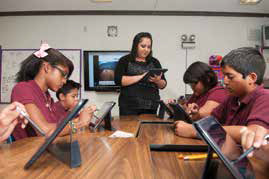THE TABLET TIPPING POINT

New Devices Designed for the Classroom Empower 1:1 Success
For a generation of “digital natives,” who have grown up interacting with touch screens and downloading apps, learning with tablets is as easy as ABC. But school districts seeking to integrate tablets into teaching and learning have encountered several key challenges. This sponsored article from Samsung looks at how new tablets designed for the classroom, together with powerful manageability solutions, are set to enable schools to scale up successfully with tablets.
With deadlines for implementing Common Core and online assessments looming, this summer will be a busy one for K-12 IT departments. According to a recent survey, just 7% of schools districts have successfully scaled up to a 1:1 device per student ratio and most say they just aren’t ready to do so.
Samsung School at Eloy Intermediate

The challenges are numerous, but at the top of the list are limited IT resources available to provision, deploy and service thousands of student devices. Over the past 18 months, Chromebooks have emerged as an effective solution, with the automatic software updates and a web-based console enabling a large fleet of devices to be centrally managed, and providing a compelling total cost of ownership comparison to traditional notebooks. According to FutureSource, a quarter of devices deployed by US schools in 2013 were Chromebooks.
Tablets, despite their rapid adoption in the consumer space, have proved more difficult to deploy on a large scale and have not always provided the platform teachers need to successfully integrate into learning. That said, with their intuitive interface and the growing availability of high-quality education apps and learning resources, tablets offer many benefits – not least of which is their potential to make learning fun. Clearly, one device does not fit all, but school districts continue to express a strong preference for tablets, especially for grades K-6.
A New Generation of Tablets
Tools and ideas to transform education. Sign up below.
Tablets may now be at the tipping point in terms of adoption, with a new generation of devices designed for the classroom and supported by new device management tools. Samsung recently introduced the Galaxy Tab 4 Education, its first tablet specifically designed to support 1:1 classroom initiatives. Compatible with Google Play for Education (available for $30 per device), schools can manage student devices through a web-based management console as well as access a wide selection of teacher-approved apps, books and videos. With Near Field Communications (NFC) technology, it is now possible to set up a classroom of tablets with just a few taps. These are significant time savings, helping to free up IT resources to focus on technology training, professional development and other strategic initiatives.
For teachers, Google Play for Education provides the ability to search approved apps by grade, subject and Common Core standard. Acquiring content is simple with easy-to-manage purchase orders. With most teachers spending three or more hours each week searching for digital learning content, this addresses another major pain point and mitigates the risk of inappropriate materials being introduced into the classroom.
Creating an Interactive Learning Environment
In addition to device management, the maturing tablet ecosystem for K-12 also encompasses digital teaching solutions that allow integration with other technology in the classroom. Samsung School, for example, creates a dynamic 1:1 learning environment combining tablets, interactive whiteboards and wireless multifunction printers.
Eloy Elementary School District in Arizona is one of a number of school districts to roll out Galaxy tablets with the Samsung School platform. Until a year ago, many students at this rural school district were disinterested in learning and needed an incentive to simply come to school. Today, student engagement has improved and attendance is at an all-time high. Technology changed everything.
“They know we’re going to include Samsung School technology in every lesson and they’re very eager to get started,” says Eloy Intermediate School teacher Irene Avila.
The school now has Galaxy tablets for every student, interactive whiteboards in each class and is using the Samsung School classroom management software to create a more participatory learning model. Samsung School enables the teacher to monitor all student screens remotely, intervening when necessary to provide personalized instruction or to keep lessons on track. The teacher can also share their screen on the interactive whiteboard at the front of the class or have a student present their work. They can assign groups for collaborative projects on a single digital canvas or conduct instant quizzes to gain immediate feedback on whether students have grasped a new concept.
“It’s exciting the way Samsung School allows us to engage our students. It gives us everything at our fingertips,” says teacher Bethany Baker, who has found the technology particularly effective with English language development students. “It brings learning to a whole new level.”
With this new breed of education tablets and the evolving ecosystem, many other schools are set to replicate the successful initiative at Eloy in the upcoming school year. And if this does prove to be the tipping point for tablets in K-12, it’s a win not only for school administrators, IT leaders and teachers, but also for a generation of tablet-loving students.
FOR MORE INFORMATION – WWW.SAMSUNG.COM/EDUCATION
